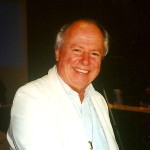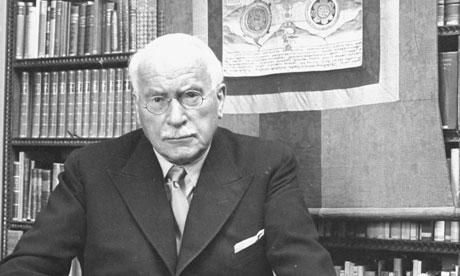Carl G. Jung (26 Jul 1875 – 6 Jun 1961): The Integration of Opposites
BIOGRAPHIES, 20 Jul 2015
René Wadlow – TRANSCEND Media Service
Carl.G. Jung was born in Kesswil on the Lake of Constance, where the three countries that most influenced him met: Switzerland, Austria, and Germany. German-speaking Switzerland was his roots, his grandfather having been the Rector of the University of Basle and a well-known medical doctor; Austria, Vienna in particular, the home of Sigmund Freud whose thought and psychological practice he championed before taking his distance; Germany whose Nazi ideology he tried to understand through his psychoanalytical tools. Moreover, family lore stated that the grandfather was the illegitimate grandson of Goethe, making Jung’s ties to German philosophy, especially an early interest in the Zarathustra of Nietzsche, all the stronger.
Jung combined an interest in German thought, especially the writings of early German alchemists with a deep interest in Chinese Taoist philosophy, the two currents are brought together in his 1951 book Aion. In Aion, he deals directly with the passage of the Piscean Period to the Age of Aquarius. He analyses astrological imagery embodied in Zodiacal ages in order to deal with the psychological problems of this period of transition. The astrological sign of Pisces is often represented as two fish − one light, the other dark in color − swimming in opposite directions. The Age of Pisces which started roughly at the same time as the birth of Jesus is the period in which Christianity developed and became the normative spiritual influence for much of the world.
The Piscean Period, true to its image of the fish going in opposite directions, has been one in which the dominant ideologies have been of opposing dualism: the kingdom of the saved and the world of the damned in Christianity, the dar al-Islam and the dar al-harb (the house of Islam and the house of war) in Islam, the antagonist socialist and capitalist worlds in Marxist thought.
The chief psychological as well as political problem of the Piscean Period was how to prevent one of the dualities from destroying the other − how to keep a balance of power. None of the dominant ideologies contained the key to a creative balance between opposites, although in the late Cold War period (1970s-1980s), the idea of “co-existence” was developed by thinkers on the edges of political power in East and West. Co-existence implied a relationship among groups in which none of the parties is trying to destroy another. Co-existence provided a starting point for succeeding generations to reframe their understanding of the enemy without necessarily abandoning other political or cultural principles.
However, co-existence is much less than the Taoist concept of equilibrium, of a balance between forces which would create greater harmony and wealth of being. Thus Jung looked to Chinese Taoism for that integration of the principles and energies of yin
(the receptive and feminine) and yang (the active and masculine). The Tao is the ground of being, the void from which all arises. As Lao Tzu in the Tao Te Ching notes,
“The Tao is like a well,
Used but never used up.
It is like the eternal void
Filled with infinite possibilities.”
In another verse Lao Tzu writes:
“The Tao is called the Great Mother:
Empty yet inexhaustible,
It gives birth to infinite worlds.”
In the infinite world of created things, the Tao is most often represented as the harmonious balance between yin and yang. Lao Tzu noted “Of the energies of the universe, none is greater than harmony. Harmony means the regulation of yin and yang.”
Jung became interested in Taoism by meeting in 1922 Richard Wilhelm, a German missionary to China, who had become very interested in Taoism. Jung viewed Wilhelm and his work as creating a bridge between East and West. Wilhelm was the messenger from China who was able to express profound things in plain language which disclose something of the simplicity of great truth and deep meaning. Wilhelm had translated a Taoist healing text The Secret of the Golden Flower to which Jung wrote a psychological commentary published in 1929. Wilhelm had also produced a translation of Lao Tzu’s Tao Te Ching as well as the I Ching (The Book of Changes) − a widely used book of Chinese divination, some of which predates the rise of Taoism in the 6th century BC.
The Chinese Taoists were directly concerned with mental health and healing, and there were contemporary healers which Wilhelm had met. The Taoist balance between what could be considered at one level as opposites was close to Jung’s psychoanalytical efforts where he contrasted the introvert and the extrovert, thought and feeling, the person and the shadow, the conscious and the unconscious. The essential task of Jung’s psychology is to help in the process of “individuation” − a process toward wholeness, which like Taoism, is characterized by accepting and transcending opposites.
As Jung noted, Taoist thought would play an increasingly powerful role in the transition between the Piscean Period and the Age of Aquarius. “The spirit of the East is really at our gates. Therefore it seems to me that the search for Tao, for a meaning in life, has already become a collective phenomenon among us, and to a far greater extent than is generally realized.”
As Lao Tzu wrote,
“Let the Tao be present in your life
And you will become genuine.
Whoever is planted in the Tao
Will not be rooted up.”
____________________________________
René Wadlow, a member of the Fellowship of Reconciliation and of its Task Force on the Middle East, is president and U.N. representative (Geneva) of the Association of World Citizens and editor of Transnational Perspectives. He is a member of the TRANSCEND Network for Peace, Development and Environment.
This article originally appeared on Transcend Media Service (TMS) on 20 Jul 2015.
Anticopyright: Editorials and articles originated on TMS may be freely reprinted, disseminated, translated and used as background material, provided an acknowledgement and link to the source, TMS: Carl G. Jung (26 Jul 1875 – 6 Jun 1961): The Integration of Opposites, is included. Thank you.
If you enjoyed this article, please donate to TMS to join the growing list of TMS Supporters.

This work is licensed under a CC BY-NC 4.0 License.

